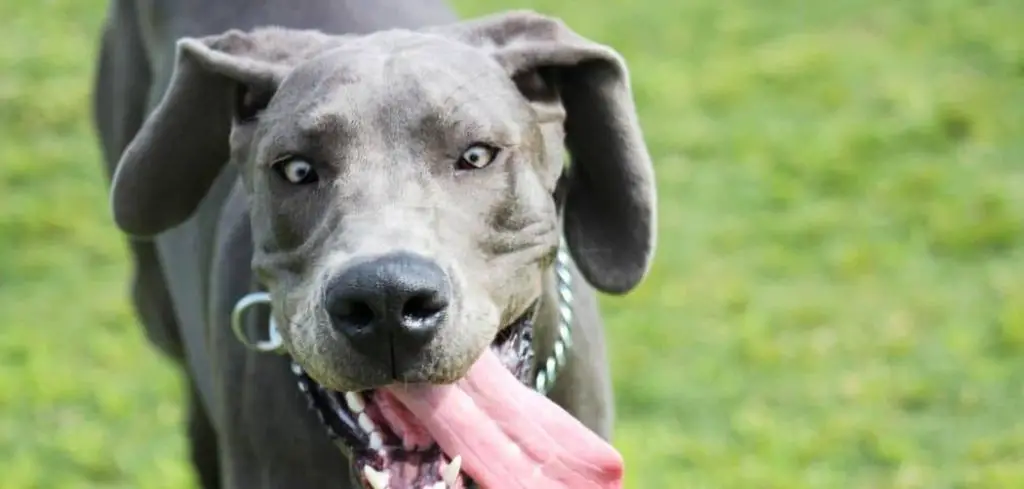Panting is a normal behavior in dogs, but constant panting can leave pet owners feeling anxious and worried. While some causes are harmless, others may indicate a more serious health condition that requires attention.
We outline the common reasons for a dog constantly panting, what you can do at home, and when to seek veterinary help.
Dog Constantly Panting — Why It Happens
A dog that is constantly panting may be dealing with anything from overheating to underlying health issues. It can happen when dogs are anxious, in pain, struggling with heart or lung conditions, or experiencing hormonal imbalances like Cushing’s disease. Heatstroke and obesity also contribute, as excess weight makes it harder for dogs to regulate their temperature.
Sometimes, panting is a warning sign of something life-threatening, making it important to look at the bigger picture of your dog’s health.

Common Causes of Dog Constantly Panting
Heatstroke
Dogs don’t sweat like humans do, so panting is their main way to release heat. When a dog overheats, panting may become excessive and constant.
Other signs of heatstroke include drooling, red gums, vomiting, and collapse. This condition is an emergency, as high body temperatures can quickly become fatal. Any dog left in a hot car or outdoors in extreme heat can develop heatstroke within minutes.
Read more: Dog Constantly Hacking (Here’s why)
Anxiety and Stress
Panting doesn’t always come from physical illness — it can also stem from emotional distress. Dogs that are anxious, scared, or stressed often pant excessively.
Situations like fireworks, thunderstorms, or even separation from their owners can trigger constant panting. This type of panting is usually accompanied by pacing, trembling, or whining.
Heart Disease
When a dog’s heart isn’t pumping efficiently, the body struggles to deliver enough oxygen. This can lead to labored breathing and persistent panting, even at rest.
Other signs may include coughing, lethargy, and intolerance to exercise. Because heart disease progresses silently, panting may be one of the earliest noticeable symptoms.
Respiratory Issues
Conditions like pneumonia, laryngeal paralysis, or chronic bronchitis make it difficult for a dog to get enough oxygen. The result is heavy or constant panting.
You may also notice noisy breathing, wheezing, or coughing. Dogs with these conditions often struggle during physical activity or in hot weather.
Pain or Discomfort
Panting is a common response to pain in dogs. Whether it’s arthritis, an injury, or abdominal pain, a dog may pant continuously to cope with the discomfort.
Unlike panting from heat, pain-related panting often happens indoors at normal temperatures. Dogs may also appear restless, refuse food, or have trouble sleeping.
Cushing’s Disease
Cushing’s disease is a hormonal disorder where the body produces too much cortisol. Dogs with this condition often develop constant panting as one of their hallmark symptoms.
Other signs include increased drinking and urination, a pot-bellied appearance, thinning hair, and weight gain. This condition develops gradually and requires lifelong management.
What to Do If Your Dog Is Constantly Panting
If your dog is panting all the time, start by assessing their environment. Make sure they aren’t too hot, and move them to a cooler area with fresh water available.
Offer a calm, quiet space if stress or anxiety might be the trigger. Gentle reassurance and keeping routines consistent can help reduce anxiety-driven panting.
Monitor for other symptoms like coughing, lethargy, vomiting, or changes in appetite. These additional signs can help you and your vet determine whether the cause is physical or emotional.
Avoid overexertion, especially in hot or humid weather. Obese dogs may need a gradual weight-loss plan to ease the strain on their breathing and reduce panting.
When to Call or Visit Your Vet
Seek veterinary help immediately if your dog’s panting is accompanied by drooling, red or pale gums, weakness, or collapse. These are warning signs of heatstroke or a severe medical emergency.
A vet visit is also necessary if your dog pants constantly indoors in a cool environment or if the panting is paired with coughing, exercise intolerance, or weight changes. These may point to heart, lung, or hormonal problems.
If pain is suspected, your vet can examine for underlying injuries or conditions like arthritis. Dogs rarely show pain in obvious ways, so panting may be one of the clearest indicators.
Because persistent panting can signal anything from anxiety to life-threatening illness, it’s always better to err on the side of caution and get your dog checked out.
Read more: Dog Constantly Coughing (Should you worry?)
Key Takeaway
Constant panting in dogs is never something to ignore. While it may be due to heat or excitement, it can also signal heart disease, respiratory issues, or hormonal imbalances.
If your dog is panting excessively, check their environment, keep them comfortable, and pay close attention to any other symptoms. Most importantly, consult your veterinarian to identify the cause and ensure your dog gets the right care.
Panting is a natural part of a dog’s life, but when it becomes constant, it’s your dog’s way of telling you something isn’t right.
